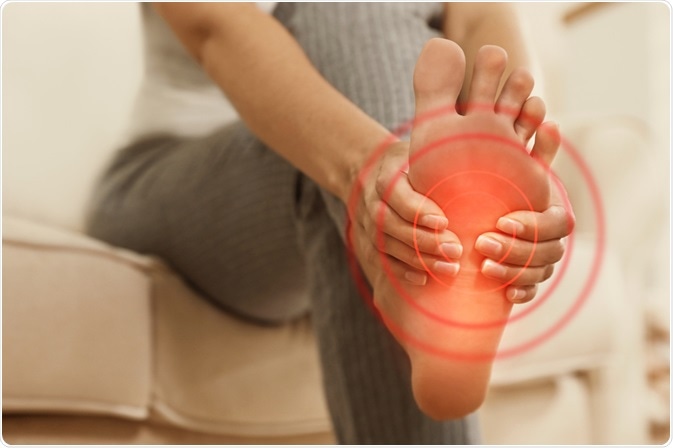Metatarsalgia is a common foot condition that involves pain in the forefoot, usually arising after the individual experiences significant stress and/or injury to the head of the metatarsals.

Image Credit: New Africa / Shutterstock.com
Foot Physiology
The weight of the body is naturally transferred to the feet when standing. As a result, there is a transfer of force between the feet and the ground during simple movements such as walking.
The first and second metatarsal heads are subjected to the most stress in this transfer of energy and may be required to support up to 275% of the bodyweight during high-impact activities such as running.

Image Credit: SciPro / Shutterstock.com
Therefore, athletes that participate in these activities are more likely to expose the metatarsals to high levels of stress, which can result in pain and inflammation.
Causes
There are several possible causes of metatarsalgia and it is associated with several other condition of the foot, including:
- Interdigital neuroma (Morton’s neuroma)
- Metatarsophalangeal synovitis
- Avascular necrosis
- Sesamoiditis
- Inflammatory arthritis
Certain people are at an increased risk of metatarsalgia, such as those who participate in high-impact sporting activities, as well as people who wear tight-fitting or high-heeled shoes that place more stress on the metatarsals.
Symptoms
The primary symptom of metatarsalgia is a pain in the foot, which may affect one or both feet. The pain typically presents gradually and gets worse over time, although it can also present suddenly following a specific injury.
The details of the pain can vary and sometimes affect a small area or, in certain cases, even affect the entire foot. Metatarsalgia-related pain can be described as feeling that there is a pebble stuck in the foot, or as a burning, aching, shooting, tingling, and/or numb sensation.
Diagnosis
The diagnosis of metatarsalgia is usually made based on the reported symptoms of the individual; however, further investigation is warranted if the pain is particularly severe or does not resolve with standard treatment. Additional testing can include blood tests, X-ray imaging, and/or other types of diagnostic imaging to investigate the involvement of other health conditions.
Management
The first step in relieving the pain associated with metatarsalgia is to allow the foot to rest and recover while also avoiding any identified causes of the pain.
For example, if ill-fitting shoes or high-impact sports are likely to have caused the condition, then these should be avoided during the recovery period. For athletes who want to continue with high levels of physical activity, alternative low-impact sports such as cycling or swimming can be recommended.
It is important for the affected individuals to allow their bodies to rest sufficiently. Elevating the feet can help to reduce pressure in the foot and aid healing, in addition to using cold therapy (e.g., an ice pack) to reduce inflammation.
Pads or insoles inserted into the shoes that help to absorb the shock and cushion the feet are also very useful in supporting the feet. This helps in both the treatment and prevention of future injury.
Pharmacological management can also help to relieve the pain for the immediate term. Simple analgesic medications, such as paracetamol or non-steroidal anti-inflammatory drugs (NSAIDs) can be very effective in relieving pain and reducing inflammation.
Although most cases of metatarsalgia can be adequately managed with these techniques, some will require more specialized treatment. This may include corticosteroid injections to cope with the pain or surgery to correct the structural abnormalities of the foot.


0 Comments